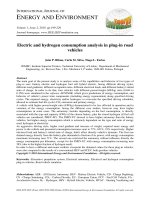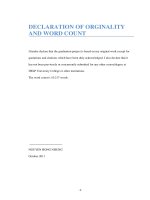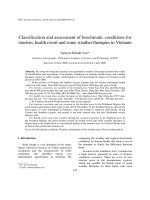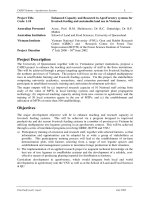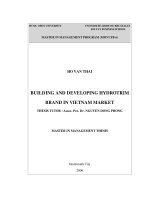Electric and Electronic Waste Recycling in Vietnam
Bạn đang xem bản rút gọn của tài liệu. Xem và tải ngay bản đầy đủ của tài liệu tại đây (5.9 MB, 48 trang )
4th INTERNATIONAL E-WASTE MANAGEMENT NETWORK
Electric and Electronic Waste
Recycling in Vietnam
Assoc. Prof. Huynh Trung Hai
School of Environmental Science and Technology
Hanoi University of Science and Technology
Hanoi, 7/2014
OUTLINE
1
E-waste in Vietnam
2 E-waste Recycling in Vietnam
3 Proper Recycling Technology
4 Conclusion Remarks
Hanoi University of Science and Technology
I. E-WASTE IN VIETNAM
The properties of e-waste in Vietnam
Does include electronic and electrical waste
Does not classified by law yet
Is considered as valuable things rather than
waste by public
Is considered as hazardous wastes by law
Is related to the transboundary flow (legal and
illegal)
There is no official data or statistic index
considering the amount of e-waste.
Have high increasing rate
Hanoi University of Science and Technology
I. E-WASTE IN VIETNAM
The properties of e-waste in Vietnam (cont’)
Can be classified by the way to handle:
• Home appliances (TV, refrigerator, washing machine,
air conditioner, PC, laptop, etc.)
• Office appliances (photocopier, scanner, printer, etc)
•
Multimedia appliances – small appliances (cellphone,
mp3 player, cameras, etc.)
Come from:
•
•
•
•
Household
Office
Industry
Oversea
Hanoi University of Science and Technology
Using
GSO, 2011
Hanoi University of Science and Technology
Second-hand market
Estimated of second-hand buying appliance in household
Quang, et.al, 2010
Hanoi University of Science and Technology
Number of discarded appliances
Unit: piece, URENCO, 2007
Hanoi University of Science and Technology
Number of discarded appliances
250
Estimated of discharged unit
(Thousands tons)
200
TV
Refrigerator
Washing machine
Air conditioner
150
100
50
0
2000
2005
2010
2015
2020
2025
Quang et.al, 2009
Hanoi University of Science and Technology
Tranboundary flow
Hanoi University of Science and Technology
Sunichi Honda, 2010
Tranboundary flow
Hanoi University of Science and Technology
Sunichi Honda, 2010
II. E-WASTE RECYCLING IN VIETNAM
Involved stake holders:
Producer/importer;
Consumer;
Collector/dismantler;
Service shop;
Recycler;
Exporter
Hanoi University of Science and Technology
II. E-WASTE RECYCLING IN VIETNAM
Hanoi University of Science and Technology
Related Activities
Related activities:
Disposal (customer)
Collection (collector)
Repairing and Refurbishing (service shop)
Dismantling (dismantling center, service shop)
Recycling (craft village for basis metals, plastic)
Burning, landfill (disposal of part/devices)
Storing, keep at home (user)
Exporting (exporter, illegal/legal)
Hanoi University of Science and Technology
Disposal
Major manners:
Sell/give to next user
Sell to the collector or service shop
Keep at home
Open dumping/disposing with domestic waste (for small)
Hanoi University of Science and Technology
Disposal
Quang, et.al., 2009
Collection
Conducted by:
Private collector and collection agent
Service shop
Sell agent (by program)
URENCO
Hanoi University of Science and Technology
… and agent
Disposal
Collection by private collector
Hanoi University of Science and Technology
Domestic
waste
Disposal
Collection
Hanoi University of Science and Technology
Service shop
Dismantling
Conducted to recover some basic materials (ferrous
copper, aluminum, plastic, lead-free glass, part/device)
Conducted in some dismantling centers (Trang Minh,
HP; Bui Dau, Phan Boi, HY; Te Lo, VP; Văn Môn, BN,
v.v.) and the service shop
Under the control of private sector
Is considered as the major recycling activity of e-waste
Hanoi University of Science and Technology
Hanoi University of Science and Technology
Hanoi University of Science and Technology
General flow of WEEE dismantling
Hanoi University of Science and Technology
The common dismantling process of TV
Hanoi University of Science and Technology
Television (TV)
• Valuable recycling
material : ~ 0.3 - 0.5 kg/unit
copper, < 1 kg steel and
aluminum, front cover (vary)
• CRT is dumped or exported
• Back cover, PCB and a part of whole CRT are exported
• Other small parts can be reused or disposed to landfill
• Rate of recycling is about 20% weight
Hanoi University of Science and Technology
Refrigerator
Type
80 liter
140 liter
200 liter
Weight (in kg)
The whole
~ 30
~ 40
~ 60
Compressor
~7
~ 10
~ 15
Case
~ 18
~ 20 - 22
~ 30 - 35
Condenser
~2
~3
~4
Others
~3
~5
~6
Hanoi University of Science and Technology
